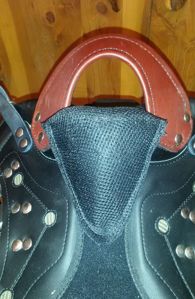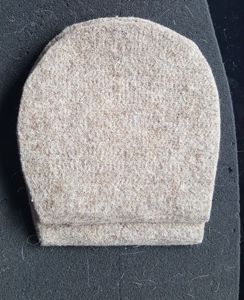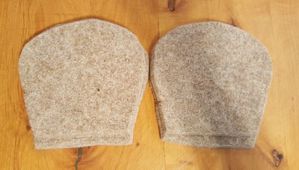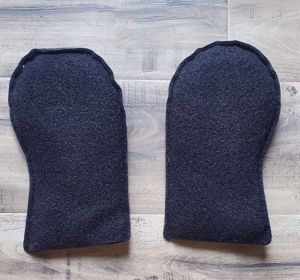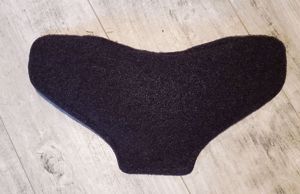Rider Balancing Aids
Shipping is included with all pricing!
Depending upon where your horse's anatomy and motion put the saddle (and we don't advise artificially fighting that as long as it's stable and properly supported by the back), the rider may feel tipped forward or back (very rare). There are several ways to balance the rider. In order of effectiveness from least to most to address rider balance:
- The Pommel Bolster (or front riser) is a wedge shaped piece that velcros between the seat and the front of the base. It can tip the pelvis a small amount and also narrows the twist and deepens the seat a bit. A popular option for all of these reasons, it can be moved forward and back for a lesser or greater effect.
- Front Cushion is a flatter triangle that velcros under the seat and can be moved for comfort and effectivements. It will tip the pelvis without adding the bulk of the Pommel Bolster.
- Panel shims are inserted into the front of the velcro opening panels and don't change the fit to the horse, but lift the rider which also helps the horse so the rider doesn't put the horse on his forehand.
- Pad shims are inserted into the front of the pad. This is easiest if switching between horses and only one needs shims. Must be used with pad inserts.
- The Pocket Shim (wedge in a velcro pocket) for closed panels works for both panel types and gives you the biggest lift in front. These work with the western skirt as well since the inserts aren't accessible.
Pommel bolster
Can affect the rider's pelvis tilt, refines the twist, and slightly deepens the seat. It goes under the front of the seat, with the wide side toward the pommel and the pointy side toward the rider. It can be moved forward/back for a greater effect.
Riders who have a low pelvic floor may not like the bolster. For those who are looking at the product to tilt the pelvis, one of the other rider balancing aids will have a great effect without discomfort.
To install, release the velcro under the front center of the seat, then tug the seat back over the front dees. Place the bolster and press the seat back into position, making sure all is still symmetrical. Replace the front velcro tab and push the seat back over the front dees. This last part can be difficult, especially when the saddle is new - to make it easier, pull some twine or a shoelace through the dee to give you more leverage.
Riders who have a low pelvic floor may not like the bolster. For those who are looking at the product to tilt the pelvis, one of the other rider balancing aids will have a great effect without discomfort.
To install, release the velcro under the front center of the seat, then tug the seat back over the front dees. Place the bolster and press the seat back into position, making sure all is still symmetrical. Replace the front velcro tab and push the seat back over the front dees. This last part can be difficult, especially when the saddle is new - to make it easier, pull some twine or a shoelace through the dee to give you more leverage.
$30.00
Panel shims
Beveled wool felt shaped to fit the front of the Ghost panel. Two pieces per side, use the bigger one alone for a 1/4" lift, both together for a 1/2" lift. You can also shim one side more than the other if your horse has a bigger shoulder (shim the smaller shoulder).
To install, turn your saddle upside down on a level surface. Remove one panel only and open the velcro tab. Push one or both shims to the very front of the panel, close the velcro and reattach to the bottom of the saddle, using the stitch line of the base for positioning while comparing to the panel still in place. Repeat for the other panel.
To install, turn your saddle upside down on a level surface. Remove one panel only and open the velcro tab. Push one or both shims to the very front of the panel, close the velcro and reattach to the bottom of the saddle, using the stitch line of the base for positioning while comparing to the panel still in place. Repeat for the other panel.
$25.00
Pad shims
If panel shims aren't enough or you have closed panels, it's also possible to shim in the pads (although the pocket shims for close panels may be a better option for both cases). You want to make sure you are still using the foam pad inserts so you don't put a transition next to the horse, plus they'll stay in place better.
One advantage of the pad shims is that they are easy to put in place while the saddle is on the horse (not girthed) and can easily be removed if one horse needs shims and another does not.
One advantage of the pad shims is that they are easy to put in place while the saddle is on the horse (not girthed) and can easily be removed if one horse needs shims and another does not.
$30.00
Pocket shim for closed panels
Wedged shim inserted between base and closed panels. Perfect for those who want the classy look of the closed panels (especially with a matching color/material) but need a little lift in front to balance the rider for horses who might be downhill where the saddle wants to side or who have less curvature than the Ghost base. These work great with velcro opening panels too, and sometimes are a bigger solution than the felt shims that can go inside the panel. This is also the best balancing solution for the western saddle. Sold in pairs.
$35.00
Front Cushion
Provides a slight lift of the seat at the front of the saddle without creating extra bulk that can be too much for people with a lower pelvic floor
$40.00

